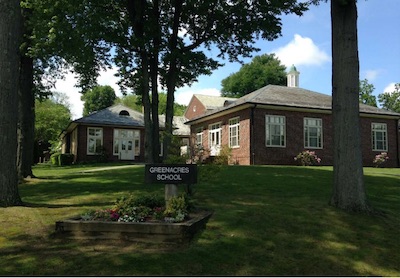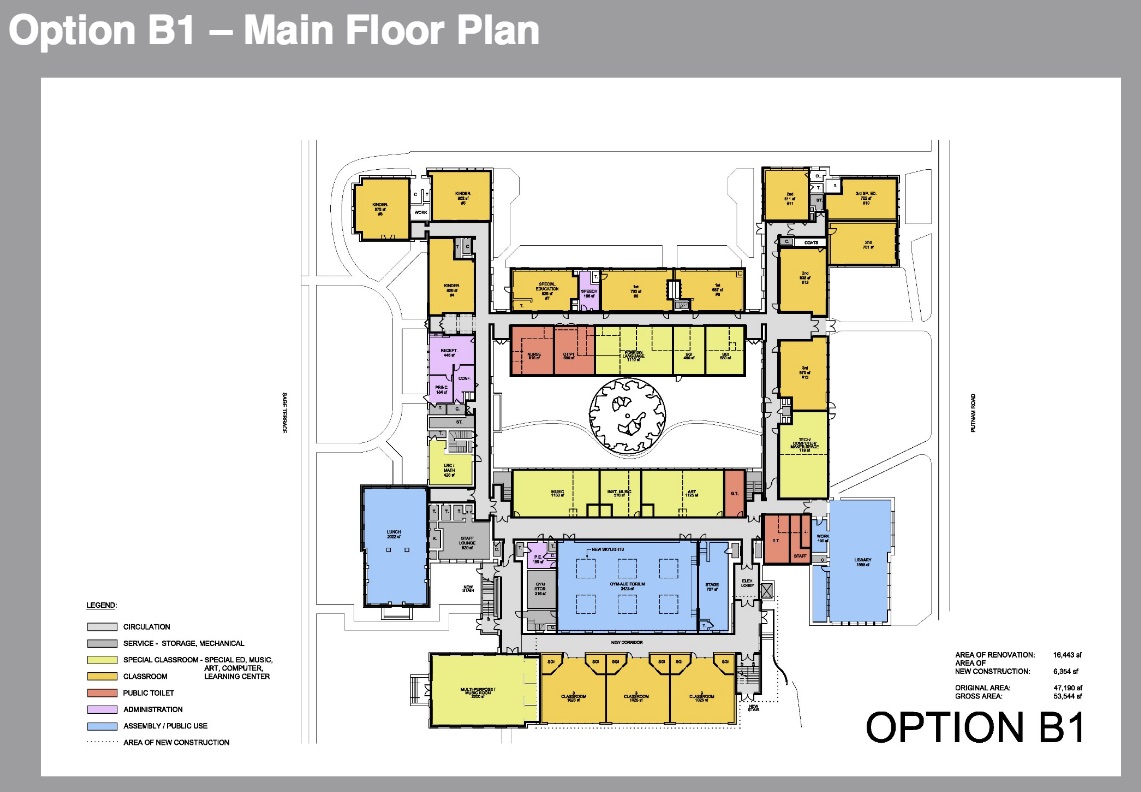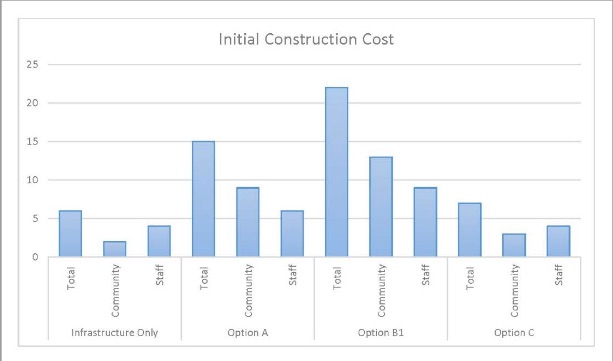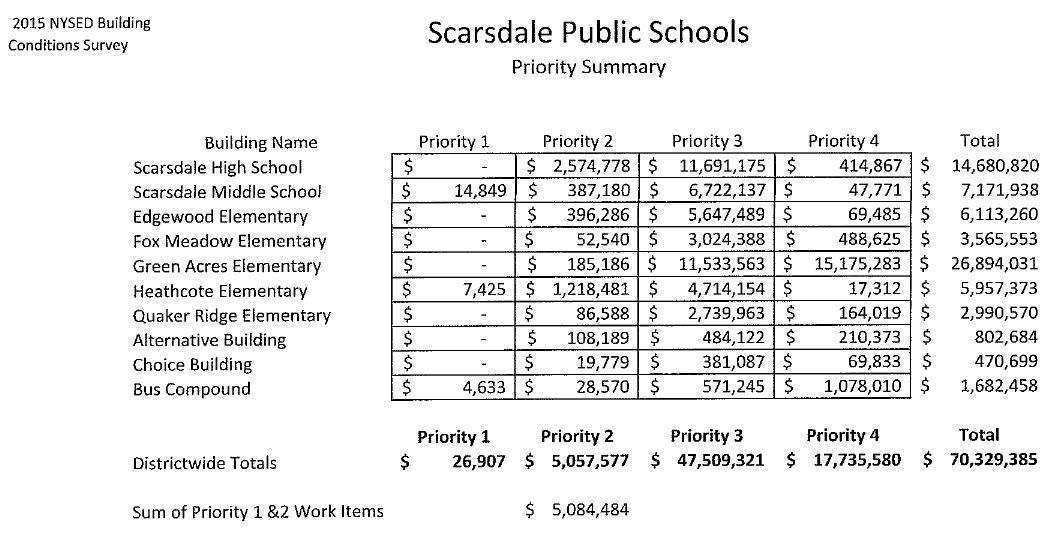School Board Weighs Options for Greenacres and District Facility Needs
- Category: Schools
- Published: Thursday, 14 January 2016 12:01
- Melissa Hellman
 The Board of Education heard the findings of the Re-convened Greenacres Building Committee on the morning of January 13 during its regularly scheduled meeting. Russ Davidson from KG&D Architects provided the background, process overview, evaluation criteria, cost estimates and finally the group's recommendation that the Board should only give further consideration to Option B1 (renovate current building with an addition) and Option C (construct a new building on the playing field across from the school). Davidson also presented the District's Building Conditions Survey which served as a reminder that Greenacres Elementary School is just one facility with a high level of need among a group of buildings which all require some attention.
The Board of Education heard the findings of the Re-convened Greenacres Building Committee on the morning of January 13 during its regularly scheduled meeting. Russ Davidson from KG&D Architects provided the background, process overview, evaluation criteria, cost estimates and finally the group's recommendation that the Board should only give further consideration to Option B1 (renovate current building with an addition) and Option C (construct a new building on the playing field across from the school). Davidson also presented the District's Building Conditions Survey which served as a reminder that Greenacres Elementary School is just one facility with a high level of need among a group of buildings which all require some attention.
When the Re-convened Greenacres Building Committee began their review process in October 2015, there were 4 options under consideration. These options have been previously been reported here:
In summary,
1. Repair building "as is" without any program related improvements.
2. Option A - renovate interior to educational model standards. No additions to the building.
3. Option B – renovate interior to educational model standards, plus build a three level addition at the north corner (Putnam Road) of the building.
4. Option C – build a new school on the open field area across the street and convert existing site into playing fields.
In the process of evaluating these options, a new version of Option B evolved (now called Option B1) in response to concern over the need to provide temporary classrooms during the proposed Option B construction period. In addition to interior renovations, Option B1 supplies an additional six classrooms and several small group instruction spaces in a two-story addition on the north side (Huntington Avenue) of the building. This addition could be built while classes go on in the existing rooms. When the new classrooms are complete, students would move into them while the existing classrooms are reconfigured and brought up to educational model standards. In the Committee's view, this option provides the benefits of original Option B with a lot less disruption. Therefore, the original Option B was eliminated from the discussion.

The Committee identified evaluation criteria and defined the following eleven assessment factors which are listed in order of importance as ranked by the Committee:
Educational Adequacy – compliance with model program standards and flexibility for a 21st century educational setting.
Building Condition Evaluation – overall condition of the building and quality of completed construction including ventilation, air conditioning, and overall interior environment.
Safety and Security – ability to provide a safe and secure experience for students and staff including arrival and departure and transit to outdoor spaces.
Historical and Community Significance – value of the historic aspects of the project and the configuration of fields and open space.
Operational Issues – total cost of the project over its entire life including maintenance, utilities and financing costs.
Disruption During Construction – extent to which normal operation of the school is disrupted.
Aesthetic Considerations – quality of the overall interior/exterior appearance of the building, site, landscape design and fit within the neighborhood character.
Initial Construction Cost - $$$
Sustainability – consideration of environmental footprint.
Accessibility – ability of the project to provide for those with disabilities.
Future Expansion Capabilities – the ability to add additional capacity.
The Committee went on to vote on how each option performed against each criterion and also identified the preference of community members and staff separately within each evaluation area. The architects and Board of Education members on the Committee did not vote. The results were tabulated and shown in graphs such as the one below on Initial Construction Cost:

There is a similar graph for each area of evaluation that can be accessed along with the entire presentation here:
The Committee recommended that Option B1 and Option C offer good solutions to all criteria measures. The estimated cost for Option B1 is $49.4 million and the estimated cost for Option C is $56.4 million. Other recommendations from the Committee include recognition of the need for additional community input, and further study on the closure of Huntington Avenue (a complicated procedure last attempted in 2011-2012 requiring petitions to the New York State Legislature) independent of the building project planning process. The very detailed Committee report can be found as part of the meeting agenda packet here.
The first public forum on the future of the Greenacres school building is scheduled for February 1, 2016. Community members are encouraged to familiarize themselves with the work that has been done to date and bring their views to the forum. The current timeline calls for this work to be incorporated into the District Wide Facilities Master Plan in May so that it may be reviewed in the context of the entire District's needs in the June-November timeframe.
On the heels of the Greenacres discussion, Russ Davidson presented the Building Conditions Survey that will serve as a major piece of input to the District Wide Facilities Master Plan referenced above. The survey report is a detailed description of the District's facilities needs and related costs for repairs and improvements. It is required by the New York State Education Department (SED) and forms the basis for the Five Year Capital Plan and Executive Summary also required by SED.
Facility needs identified by the survey fall into 4 categories:
Priority 1: Urgent work required for safety or to prevent imminent facility damage.
Priority 2: Health and safety work required by current building code.
Priority 3: Replacement of aging building systems, general maintenance and efficiency improvements.
Priority 4: Desirable improvements related to appearance, functionality and curriculum.
The estimated costs of work identified by the report are broken down by priority category below:

The line item details and breakdown by school are available as part of the agenda packet distributed for the meeting here. It includes needs for repair or replacement of items in each building such as roof work, HVAC systems, lighting, stair rails, doors, windows, fire alarm systems, masonry work, and aesthetic and program related improvement items large and small across the facilities.
Of importance to note is that the total cost of priority 1 and 2 items is $5 million reflecting the well-maintained condition of the District's buildings. Also important is that the cost of the Greenacres facility "as is" option ($26 million) is included in this total number. Further, no one should interpret the above chart to mean that the District needs to immediately undergo $70 million of facilities remediation. As was stated by BOE member Pam Fuehrer "I don't think any of us can expect that we are going to tackle the $70 million from that survey now or in two years or in four years" describing it as more of a long term plan.
Whatever work is selected to be completed either out of necessity or aspiration would be financed by a few different sources (i.e. the yearly capital improvements budget) but primarily with the bond issuance being planned for 2017. The bond financing that would be available at that time without any tax impact is projected to be about $62 million dollars and the Board of Education will have to balance how much of this money would be allocated to the Greenacres school building versus other facilities' needs.
Board Member Suzanne Seiden reminded the Board and Administration that although it may seem that Greenacres would be receiving a disproportionate amount of the proceeds from the proposed bond, part of the reason for this situation was an intentional decision by the Board to handle Greenacres as a separate matter given the scope of the work required there. Facilities improvements to Greenacres were deferred during the discussion of the 2014 bond issue for this reason. Seiden's tenure on the Board will be ending this year. Her reminder was crucial as the Board is possibly in a position where they will be asking the community to vote in May 2017 on a very large bond issue (as a comparison the 2014 Bond was $18 million) to primarily finance needs at a single elementary school. The public may not have the institutional memory to consider what was discussed or decided in previous years when it comes time to pull the lever.
In the context of balancing the facilities needs of the entire District, the Board will have a discussion at the next meeting as to whether or not it will be reasonable to consider Option C for Greenacres. Although the difference between the total costs of the two options is projected to be at $7 million, Option B1 is structured so that it could be implemented in phases spreading the cost out over time and changing direction if necessary. Option C is all or nothing. The Board was clear that it was not going to come to any resolution on this topic prior to getting input from the community at the February 1 forum. However, Board members also expressed concern that it would be false to go into the forum with both options on the table equally if in fact the current information available regarding the District financial position precludes giving Option C reasonable consideration.
During the comment period Barbara Wenglin of Greenacres spoke in support of Option B1 and in support of the upcoming community forum. Amy Hosseinbukus of Greenacres asked the Board to give serious consideration to Option C. She expressed that the difference in projected cost of $7 million was not so high considering the prospect of an entire new state of the art building versus the old building renovated with an addition. She said that she hoped the very vocal group of Greenacres residents who opposed the location of the proposed new building did not dissuade the Board from entertaining this option. She stated that she herself felt intimidated about speaking her opinion because of the perception of supporting Option C as an unpopular view in the Greenacres community.
These two topics represent only a portion of an over three hour meeting covering updates on the Transition Plan, a proposed Special Education Program for Emotional Disabilities at the high school and a preliminary review of new personnel requests to be considered for next year's budget. View the meeting and discussion in its entirety at Scarsdale's Video on Demand Site here. The next regularly scheduled Board of Education meeting is Monday, January 25 beginning at 6pm.







